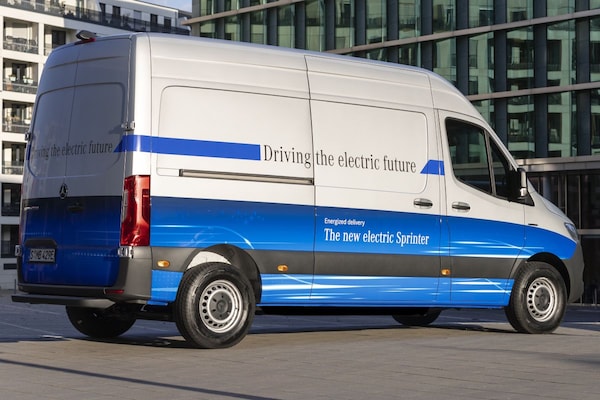One of the hallmarks of the Mercedes-Benz Sprinter is the huge choice of body styles, from modest to huge. With the electric version, the choice is limited to a single model. Does it live up to the high expectations associated with the Sprinter name?
If there is one electric van that has taken a long run, it is the eSprinter from Mercedes-Benz; the prototype was already shown at the 2016 IAA Nutzfahrzeuge. And the manufacturer has now announced that it is working on a completely new platform for the successor. The future eSprinter platform is not hot news, because it has already been presented to the press and public by Daimler at the end of 2020. It’s about it Electric Versatility Platform, which will of course succeed the platform of the existing version at a time that has not yet been specified. What is remarkable about this is that Mercedes-Benz consciously opts for rear-wheel drive, because the car must be better suited to carry very heavy loads. Currently, front-wheel drive is the only option, and apparently also a very logical one for a van for mainly urban distribution, where a maximum load volume is the norm. If not in the future, it turns out, when many more tasks lie ahead for the eSprinter. A gratifying prospect, of course, knowing that EVs will eventually replace diesels. It’s not that far yet, so let’s take a look at what exactly we have in our hands with the existing eSprinter.

Three or four packs
The eSprinter is always a panel van in the L2 version with a raised roof; there are simply no other configurations or a flatbed version. They have been announced for the future platform. In terms of battery capacity, the eSprinter offers a choice of two variants. The standard is 35 kWh, good for a range of 120 kilometers and a payload of 1,045 kg. 47 kWh is optionally available, which gives a higher driving range (168 kilometers), but also a reduced payload (in this case 891 kg). It has no influence on the loading space itself, which is 11 m3 each time, because the batteries (three and four packs respectively) are housed entirely under the loading floor. In both cases there is an electric motor of 85 kW and a pulling force of 300 Nm. To immediately pick up on the latter: it sounds like a fair amount of power to the front wheels, but in practice it is quite disappointing. There is a choice of driving modes E+ (extra economical driving, with limited use of air conditioning and heating, maximum power 70 kW, torque 270 Nm), E (energy-saving, but retaining all functionalities) and C (comfortable driving, with maximum performance and optimal operation of air conditioning and heating). Even in position C, the unloaded eSprinter had to pull out all the stops to, for example, be able to drive off smoothly on a provincial road, where the rest of the traffic is rushing at you with at least 80 km/h – at least that’s how it feels. When merging onto the highway, the run-up is longer, but there too you feel very passive and you have to wait until a hole in the right lane is free in front of you. And you consider yourself lucky when the slip road leaves from, for example, a viaduct, so that the difference in height helps you to speed up the pace. The top speed is standard 100 km/h, but can also be set at 80 or 120 km/h if desired. So many ‘shelves’ during the fairly short test drive, which resulted in an average consumption of 29 kWh/100 km. Charging can be AC (7.4 kW, up to 100% in 6 to 8 hours or 20 kW in 1:30 hours) and DC (100 kW from 10 to 80% in 0:25 hours).

Unroll
Its out-of-town performance, sadly tame, is a blot on the eSprinter’s otherwise wrinkle-free blazon. As long as the speeds are not too high, the electrical power makes it a pleasant and, above all, extra easy-to-handle partner for everyday use. It is in no way inferior to the diesels, but of course offers the advantage of the inaudible and emission-free engine. There is also a neatly executed set of instruments, specifically developed for the EV version, with all the information you want. Like the eVito and EQV, it offers the option of regenerating kinetic energy via paddles in four gradations. That gives a nice feeling of control, because you can let the car slow down to the maximum or let it roll out seemingly endlessly. Driving without a brake pedal completely is nevertheless a step too far. The suspension comfort and other features are completely as with the well-known Sprinters, except that contact can also be made with the car via smartphone (via ‘Mercedes PRO’), which is useful for both driver and fleet manager. Only that one available L2 version just has to fit into your business; a pity that the almost endless choice of the Sprinter is not applicable to the electric version. The price point is competitive, with €55,135 (35 kWh) and €62,642 (47 kWh).
– Thanks for information from Autoweek.nl
